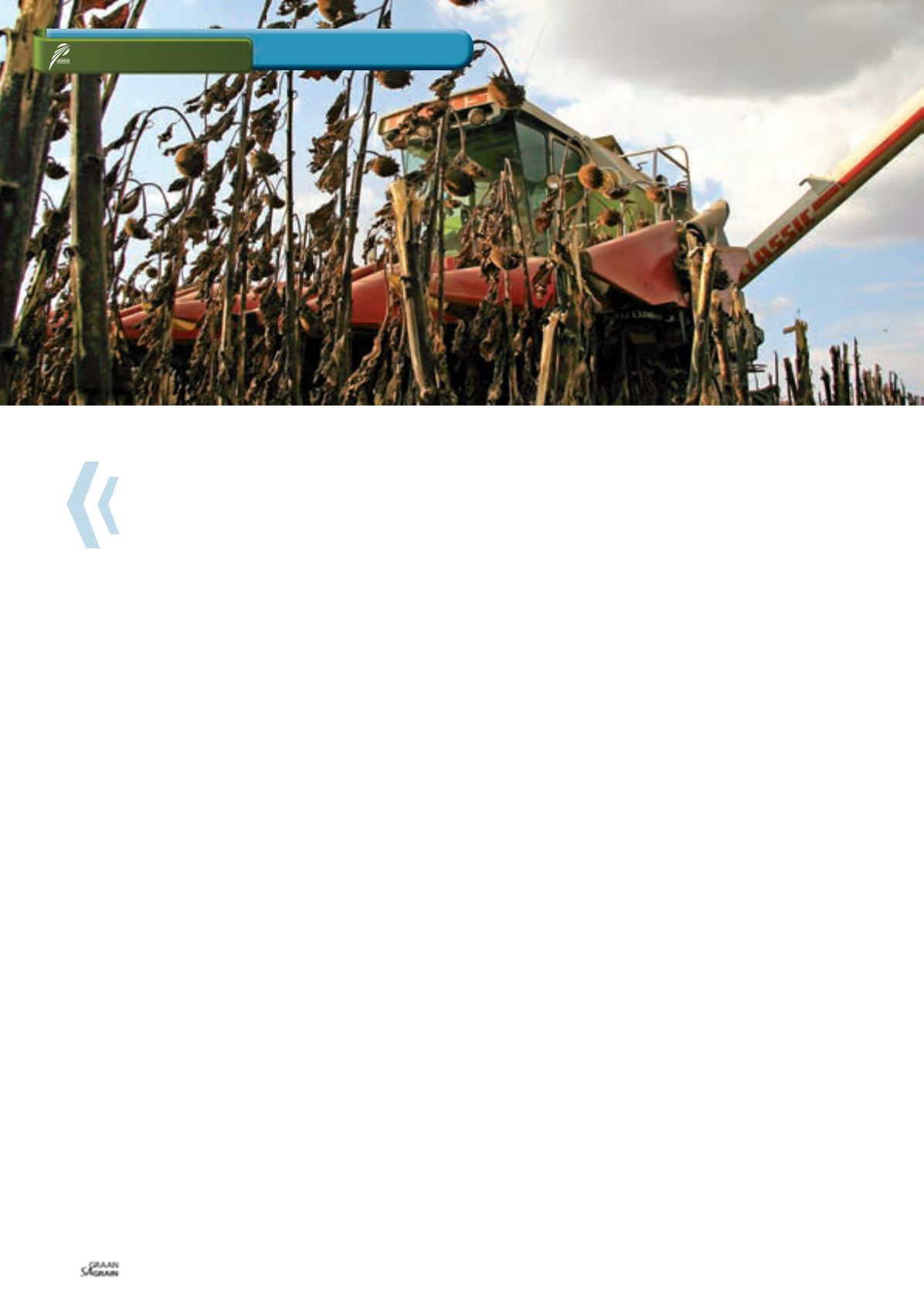

Oktober 2016
90
RELEVANT
Damaged sunflower seed by definition means sunflower seed or
portions thereof which is visibly discoloured as a result of external
heat or heating due to internal fermentation.
The Free State (69 samples) reported the highest weighted
average percentage screenings, namely 2,40%, followed by North
West (N = 86) and Mpumalanga (N = 98) with 1,91% and 1,67%
respectively.
Limpopo (eight samples) reported the lowest average percentage
screenings of 1,28%. The weighted national average was 2,05%
compared to the 1,69% of the previous season. See
Graph 1
.
As in the previous season, the highest weighted percentage
foreign matter (2,18%) was reported for the samples from Gau-
teng (N = 5). The Free State and North West averaged 1,15% and
1,16% respectively. The lowest average percentage was found in
Limpopo at 0,71%. The South African average of 1,17% was the
lowest of the last three seasons.
Sclerotinia did not pose a problem on any of the samples received
for this survey and was observed on only eight of the samples. The
highest percentage (3,03%) was present on a sample from Gauteng,
this is, however, still well below the maximum allowable level of
4%. Sclerotinia was not observed on any of the samples from Lim-
popo. Weighted averages ranged from 0,01% in the North West to
0,02% for both the Free State and Mpumalanga.
Gauteng showed the highest weighted average of 1,01%. The nation-
al average of 0,04% compared well with the 0,01% of the 2012/2013
season and was lower than the 0,53% of the previous season.
Test weight, providing a measure of the bulk density of grain and
oilseeds, does not form part of the grading regulations for sun-
flower seed in South Africa. An approximation of the test weight of
South African sunflower seeds was done by determining the g/1 L
filling weight of sunflower seed by means of the Kern 222 apparatus.
The test weight was then extrapolated by means of the following
formulae obtained from the test weight conversion chart for sun-
flower seed oil of the Canadian Grain Commission: y = 0,1936x
+ 2,2775 (138 to 182 g/0,5 L) and y = 0,1943x + 2,1665 (183 to
227 g/0,5 L).
The national weighted average test weight was 44,2 kg/hl, compared
to the 41,3 kg/hl and 43,4 kg/hl of the previous two seasons. Values
ranged from 34 kg/hl to 50,5 kg/hl this season. Provincial averages
varied from 41,9 kg/hl in Mpumalanga to 44,8 kg/hl in Gauteng. All
of the sunflower samples were milled on a Retch ZM 200 mill fit-
ted with a 1 mm screen, prior to nutritional component analyses.
The crude protein, -fat, -fibre and ash components are reported as
% (g/100 g) on an ‘as received’ or ‘as is’ basis.
The Dumas combustion analysis technique was used to determine
the crude protein content, according to AACCI method 46-30,01,
latest edition. Combustion at high temperature in pure oxygen
sets nitrogen free, which is measured by thermal conductivity de-
tection. The total nitrogen content of the sample is determined and
converted to equivalent protein by multiplication with a factor of
6,25 to obtain the crude protein content.
The weighted average crude protein content of the 2014/2015
season was 16,96% - 0,81% higher than the previous season and
0,17% higher than in the 2012/2013 season. The North West had
the highest weighted average crude protein content of 17,53% and
the Free State the lowest with 16,27%. See
Graph 2
.
Fat is extracted by petroleum ether with the aid of the Soxhlet
extraction apparatus, followed by the removal of the solvent by
evaporation and weighing the dried residue thus obtained. The
weighted average crude fat percentage of 39,7% compared very well
with the 39,6% and 39,2% of the two previous seasons. Gauteng
had the highest weighted average crude fat content of 41,4%. The
lowest average fat content was observed in Limpopo (38,8%). The
North West and the Free State averaged 39,2% and 40,4% respec-
tively (
Graph 3
).
The weighted average percentage crude fibre decreased slightly
from 20,2% in the previous season to 20% this season and equalled
the 2012/2013 value. The values varied between 19,1% in Gauteng
to 20,7% in Mpumalanga. The in-house method used determines
crude fibre as the loss on ignition of the dried residue remaining
after digestion of the sample with 1,25% sulphuric acid (H
2
SO
4
) and
1,25% sodium hydroxide (NaOH) solutions under specific conditions.
Ash is defined as the quantity of mineral matter which remains as
incombustible residue of the tested substance, after application of
the described working method. SAGL uses an in-house method,
based on AACCI method 08-03.01. The samples were incinerated at
600 ± 15°C in a muffle furnace for two hours. The national weighted
average ash content is slightly lower (2,55%) than last season (2,66%)
but similar to 2012/2013 (2,54%). The provincial averages ranged
from 2,45% in Gauteng and Mpumalanga to 2,58% in the Free State.
The results of this survey are available on the SAGL website
(
www.sagl.co.za ). The hard copy reports are distributed to all the
directly affected groups and interested parties. The report is also
available for download in a PDF format from the website.
Sunflower crop quality
Grain SA/Sasol photo competition

















